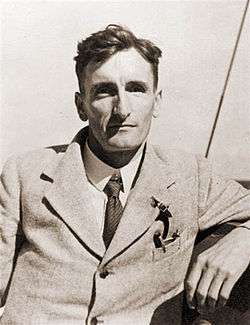Guy Stewart Callendar
| Guy Stewart Callendar | |
|---|---|
|
Guy Stewart Callendar in 1934 | |
| Born |
February 1897 Montreal, Canada |
| Died | October 1964 (aged 67) |
| Nationality | English |
| Known for | Callendar Effect |
Guy Stewart Callendar (February 1897 - October 1964) was an English steam engineer and inventor. His main contribution to knowledge was developing the theory that linked rising carbon dioxide concentrations in the atmosphere to global temperature. This theory, earlier proposed by Svante Arrhenius,[1] has been called the Callendar effect. Callendar thought this warming would be beneficial, delaying a "return of the deadly glaciers."[2]
Life
Callendar was the son of Hugh Longbourne Callendar, an English physicist who studied thermodynamics.
Career
Callendar's professional work focused on steam and pressure under the patronage of the British Electrical and Allied Industries Research Association, which represented turbine manufacturers. He later focused on research into batteries and fuel cells.[3] Although Callendar was an amateur climatologist,[4] he expanded on the work of several 19th century scientists, including Arrhenius and Nils Gustaf Ekholm as a hobby. Callendar published 10 major scientific articles, and 25 shorter ones, between 1938 and 1964 on global warming, infra-red radiation and anthropogenic carbon dioxide. Other scientists, notably Gilbert Plass and Charles Keeling, expanded upon Callendar's work in the 1950s and 1960s.[3]
Research
In 1938, Callendar compiled measurements of temperatures from the 19th century on, and correlated these measurements with old measurements of atmospheric CO2 concentrations.[1] He concluded that over the previous fifty years the global land temperatures had increased, and proposed that this increase could be explained as an effect of the increase in carbon dioxide.[5] These estimates have now been shown to be remarkably accurate,[4] especially as they were performed without the aid of a computer.[6] Callendar assessed the climate sensitivity value at 2 °C,[7] which is on the low end of the IPCC range. His findings were met with scepticism at the time; for example, Sir George Simpson, then director of the British Meteorological Society thought his results must be taken as a coincidence.[8] However, his ideas did influence the scientific discourse of the time, which had been generally sceptical about the influence of changes in CO2 levels on global temperatures in the previous decades after debate over the idea in the early 20th century.[3] His papers throughout the 1940s and 50s slowly convinced some other scientists of the need to conduct an organised research programme on CO2 concentrations in the atmosphere, leading eventually to Keeling's Maunu Loa measurements which proved pivotal to advancing the theory of anthropogenic global warming.[3] He remained convinced of the accuracy of his theory until his death in 1964 despite continued mainstream scepticism.[8]
See also
References
- 1 2 American Institute of Physics, The Discovery of Global Warming: The Carbon Dioxide Greenhouse Effect, February 2014 (accessed 13 November 2014)
- ↑ Bowen, Mark (2006) Thin Ice, p. 96. New York, Henry Holt. ISBN 978-0-8050-6443-8
- 1 2 3 4 Fleming, James Rodger (1998). Historical Perspectives on Climate Change. Oxford: Oxford University Press. ISBN 0195078705.
- 1 2 Hawkins, Ed & Phil Jones (2013) "On increasing global temperatures: 75 years after Callendar", Quarterly Journal of the Royal Meteorological Society, doi: 10.1002/qj.2178
- ↑ Callendar, G. S. (1938) "The artificial production of carbon dioxide and its influence on temperature", Quarterly Journal of the Royal Meteorological Society, doi: 10.1002/qj.49706427503
- ↑ Fleming, J.R. (2007) The Callendar Effect: the life and work of Guy Stewart Callendar (1898–1964) Amer Meteor Soc., Boston. ISBN 978-1-878220-76-9
- ↑ Archer, David; Rahmstorf, Stefan (2010). The Climate Crisis: An Introductory Guide to Climate Change. Cambridge University Press. p. 8.
- 1 2 Hulme, Mike (2009). Why We Disagree About Climate Change. Cambridge University Press. pp. 50–52. ISBN 978-0-521-72732-7. Retrieved 28 January 2016.
Bibliography
- Fleming, J.R. (2007) The Callendar Effect: the life and work of Guy Stewart Callendar (1898–1964) Amer Meteor Soc., Boston. ISBN 978-1-878220-76-9
- Fleming, J.R. (1998) Historical Perspectives on Climate Change Oxford University Press, New York. ISBN 0-19-507870-5
External links
- Greenhouse Speculations: Arrhenius and Callendar by Spencer Weart
- G.S. Callendar Archive, University of East Anglia
